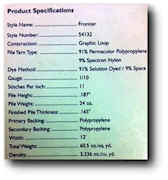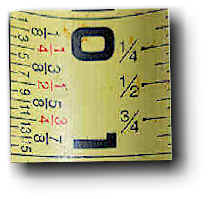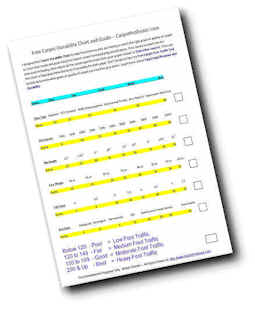How To Choose New Flooring Like A Pro!
List of Preferred Local Flooring Stores
(Free Information by Consumer Advocate - No Flooring Sales)
Carpet Specifications Explained
Understanding Carpet Specifications is the only sure-fire way for you to determine how durable a carpet is, how long it is designed to last, to help determine its value, and if it is able to meet your needs, goals, lifestyle and budget.
How is Carpet Graded?
Carpet is graded by the quality and configuration of the materials used including; the Fiber Type; the Fiber Face-Weight; the Tuft Twist Rating; the Pile Density Rating; the Pile Height; and how well it is constructed overall (Including Dye methods; Backing systems; and Manufacturing processes).
"Determining which carpet is the absolute best choice for a particular application can be challenging even for a seasoned carpet professional."
The Carpet "Specification" Label
On the back of almost every retail Carpet Sample there should be a manufacturer's label that shows the...
-
Type of Fiber
-
Pile Density Rating
-
Tuft Twist
-
Face-Weight of the pile
-
Pile Height
This is must-have information that every homeowner needs to help determine how durable the carpet is and determine its value. Specifications also help determine whether or not the carpet would be a suitable choice to meet your needs and goals.
Other information that may shown on the manufacturer's label:
-
The stain treatment applied (e.g., Scotchgard, R2X);
-
The brand name (e.g., Shaw, Mohawk, Karastan);
-
The style name (e.g., Enchanted Evening II); and
-
The color name or color number (e.g., Forest Green or FG-124).
-
Warranty limits.
Learn more about Carpet Stain Warranties
Carpet Specifications Often Hard to Obtain
Once you find a carpet you like, you need to have full access to the specifications before you buy.
If the label is missing, or does not provide all the information you need, then you need to ask the salesperson to provide you with the manufacturers Carpet Spec Sheet.
 This is
usually a one-page report from the carpet
manufacturer that provides all the carpet specifications regarding the carpet
style in question.
This is
usually a one-page report from the carpet
manufacturer that provides all the carpet specifications regarding the carpet
style in question.
The carpet salesperson may have to call the manufacturer to ask for it, or call their local carpet mill representative to request the specifications you need.
This can be time consuming and frustrating for you. (Another reason why I have a hand-picked list of recommended carpet dealers)
Q. I’ve tried to follow your advice and look for the right Face-Weight, Pile-Density and Tuft-Twist to last 10-15 years...
-
The only places that I can find who have these specifications listed on their carpet samples are the big box retailers.
-
The local carpet retailer near me doesn’t list the carpet specifications on their samples.
-
The salespeople might know the face-weights but often don’t know the Tuft-Twist or Pile Density.
Why don’t all carpet dealers post carpet specifications on their samples?
Answer:
Many carpet dealers do list all or some the carpet specs on their carpet samples, but some do not list any at all. Maybe they think homeowners should select their new carpet based on price, color and cost.
I firmly believe it’s very important for homeowners to have complete access to all the carpet specifications. It’s the only way to accurately determine the grade or quality level of the carpet in question. How else can you determine if the carpet would be a good choice based on the homeowners individual needs, goals, lifestyle and budget?
Sadly, not all locally-owned dealers are honest and reputable, and some carpet salespeople are reluctant take the time to provide their customers with carpet specifications because it can be a “hassle” to do so. The problem is partly due to private labeling, retail competition, and partly due to salesperson laziness.
Some carpet retailers don’t want you to be able to shop around for the lowest price (comparison shop) so they limit the amount carpet information available. They may even change the style and color names to make it difficult to compare prices with other local retailers.
3 Ways Dealers Get Carpet Specifications
1. Dealers can call the Carpet Manufacturer directly – most carpet mills are happy to fax or email the carpet " spec sheet". You can also call the carpet manufacturer yourself as long as you have all the key information about the carpet in question. The manufacturer; the style name; the color name; or color number.
2. Dealers can login to their online carpet mill account - to gain access to carpet specifications. This may require a store manager to login to obtain the information you want. It is easy for them to do, if they are willing to take the time to do it.
3. Dealers can call their Carpet Mill Representative to obtain the information you need. Every carpet retailer has the cell phone number to reach their carpet account representative. It may take a day or two for their mill rep to provide the carpet specs you want, but they can provide it if they are willing to take the time. If they don't, then I suggest you buy from another dealer who will!
When To Ask For Carpet Specs?
Most homeowners take several carpet samples home for a few days and narrow down their carpet selections to three or four good choices and then ask for the spec sheets to compare them all side by side.
It’s true that the carpet manufacturers are not putting the detailed construction information on their carpet samples like they used to in the past, but any decent carpet salesperson should be willing to get you the information you seek. However, you have to ask for it and be patient enough to wait for the information to be acquired, and it may take a day or two for the salesperson to get it.
Take your time making your final selection and don’t be afraid to take a week or two to think about it. Never let any salesperson pressure you into buying right now for any reason. It’s common for salespeople to urge you into buying right now by saying the sale will be ending soon or that the current prices are about to increase.
The Salesperson Says "Can't Get Specifications"?
There's only one carpet manufacturer that I have ever known to refuse to provide carpet specifications to their dealers and to consumers, and that mill was Karastan. However, now they have been providing specs to consumers. I have a list of phone numbers you can call to ask for carpet specs here.
All other carpet makers are willing to provide carpet specifications to their dealers; and often to homeowners directly either by phone, by fax, snail mail, email or on the internet.
You may need to be patient and give the salesperson sufficient time to call and get the information for you. (It may take a few days) However, if your carpet salesperson refuses to provide all the carpet specifications you need, then you might want to give your business to a retailer who will.
Call the Carpet Manufacturer Yourself
You can always call and ask for the carpet specifications yourself as long as you have the manufacturer's brand name and the carpet style name. Here is my List of Carpet Mill Websites and their phone numbers.
Learn how to mathematically Figure Out Carpet Specs.
How to Choose the Right Carpet Fiber?
The most critical factor for every homeowner to consider is the Fiber Type. I created a special article that reveals everything you need to know about Carpet Fibers.
Pile Density Rating vs. Carpet Durability
Dig your fingers into the pile of the carpet. Are the fibers tightly packed or can you easily see the carpet backing? The more densely the tufts are packed together the more durable the carpet will be. Pile Density is a major key to having a carpet retain its like-new appearance longer.
The Density rating is determined by pile yarn weight, pile thickness and pile height. Think of it like a densely wooded forest where the trees are thick and packed closely together.
Pile Density ratings range from 1000 to 6000 and is determined using a mathematical formula based on the Pile Height and the Fiber Face-weight.
Here is the formula:
Fiber Face-Weight x 36, divided by pile height (in decimal form) = Pile Density.
For example: a 35-ounce face-weight carpet with a half inch (1/2") pile height would have a pile density rating of 2520. (35 x 36 divided by .5 = 2520).
Learn how to calculate or Figure Carpet Specifications
What is Carpet Face-Weight?
Face-weight is the actual weight of the fiber used to manufacture the carpet pile, but does not include the weight of the carpet backing.
Fiber Face-weight is not the same as Total Carpet Weight, which includes the weight of the carpet backing and the fiber face-weight.
Most carpets have a face-weight between 20 ounces and 100 ounces, but the average face weight for a residential carpet is about 45 ounces.
A higher face weight does not automatically mean the carpet is a better grade; is a higher quality; is more durable; or is more costly. Pile Density is the most important factor next to Fiber Type.
What is Carpet Pile Height?
 Carpet
pile height refers to the length of the fibers or yarns that make up the carpet.
A higher pile height can make a carpet feel softer and more luxurious, but it
can also make it more difficult to vacuum and maintain.
Carpet
pile height refers to the length of the fibers or yarns that make up the carpet.
A higher pile height can make a carpet feel softer and more luxurious, but it
can also make it more difficult to vacuum and maintain.
A lower pile height is typically easier to clean and a better choice for high-traffic areas. While this measurement may not be listed on a carpet sample, it can easily be determined with a tape measure. Pile height is measured from the surface of the carpet to the backing material.
To prevent the fibers from becoming matted or crushed over time, I recommend choosing a pile height of 3/4" or less. This is especially important for carpets made of polyester, as they are more prone to matting. By selecting a shorter pile height, you can help ensure your carpet will maintain its beautiful appearance and increased durability for years to come.
What is Carpet Tuft-Twist Rating?
The Tuft Twist is a major key to having your carpet retain its like-new appearance longer. This is very similar to the way women might use a curling iron to create curls in their hairstyles. The tighter the tufts are twisted together, the more durable the carpet will be, and the longer the carpet can maintain its like-new appearance.
Carpet fiber is also called yarn, and is extruded to form a single strand or "filament", These filaments are similar in size to a human hair. The carpet fibers are grouped together to form tufts and are twisted while heat is applied to "set" the fibers permanently, hence the term "heat set".
This tuft has 7 twists and is a sign of a well-made, more durable carpet. Frieze styles have tufts similar to this.
This tuft has 4 twists and is not as durable. When it comes to choosing carpet, it's important to pay attention to the tuft twist rating. This rating is based on the number of twists per lineal inch of the tuft and can range from 3.0 to 9.0.
A higher Tuft Twist count, such as 6 or more, is a sign of a more durable carpet that will retain its like-new appearance longer. On the other hand, a tuft with only 4 twists is a sign of a lower-grade carpet, often found in inexpensive plush styles.
If you want a great carpet that will last longer, consider choosing a nylon frieze style with a higher tuft twist rating. Frieze styles typically have a tuft twist of more than 6.
Why Does a Good Tuft-Twist Rating Matter?
Carpets with a low Tuft Twist Rating (3 to 5) tend to untwist or “blossom” at the tuft tips more quickly, thus creating a worn out, frizzy looking or matted down appearance. Carpets seldom wear out from the loss of fiber, they just start to mat down; gradually lose the luster and shine; and just start to look bad.
Once the tufts have blossomed and become matted down, it cannot be reversed. For this reason a Carpet with a higher Tuft-Twist (5.5 to 7.5) will retain its like-new appearance longer and tolerate a higher level of foot traffic.
When comparing similar quality carpets side by side, you must consider the tuft twist rating to help you determine which carpet is the better choice. Carpets with a lower tuft twist rating tend to "blossom" more quickly and as a result will be less durable and will appear word out sooner.
Use my free Carpet Durability Chart to better understand how carpet durability is determined in part by the number of twists each tuft has. Frieze styles typically have a very high tuft twist rating of at least 6 or more. That's the main reason why frieze carpets tend to wear better and last longer than many other carpet styles.
__________________________________________________________
Carpet Professor's
Carpet Durability Guide Chart
 I designed
this chart to help homeowners who are hoping to select the right
grade or quality level of carpet to meet their needs and goals.
I designed
this chart to help homeowners who are hoping to select the right
grade or quality level of carpet to meet their needs and goals.
This chart considers several carpet manufacturing specifications to calculate a score.
(Click on the image to view larger or print PDF)
First,
locate a carpet you are considering buying, then obtain all the carpet
specifications from your local carpet retailer. Then use
this chart to help determine the level of durability for that carpet.
More Information:






